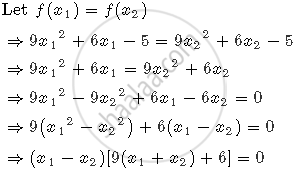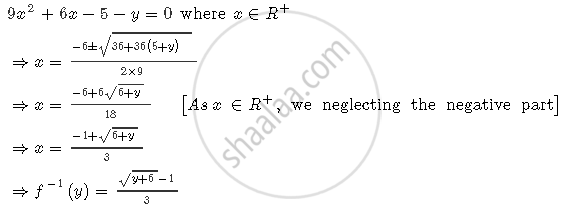Advertisements
Advertisements
प्रश्न
Consider f: `R_+ -> [-5, oo]` given by `f(x) = 9x^2 + 6x - 5`. Show that f is invertible with `f^(-1) (y) ((sqrt(y + 6)-1)/3)`
Hence Find
1) `f^(-1)(10)`
2) y if `f^(-1) (y) = 4/3`
where R+ is the set of all non-negative real numbers.
उत्तर
f: `R_+ -> [-5, oo]` given by `f(x) = 9x^2 + 6x - 5`
To show: f is one-one and onto.
Let us assume that f is not one-one.
Therefore there exist two or more numbers for which images are same.
For x1, x2 ∈ R+ and x1 ≠ x2

Since x1 and x2 are positive,
9(x1 + x2) + 6 > 0
∴ x1 − x2 = 0⇒ x1 = x2
Therefore, it contradicts our assumption.
Hence the function f is one-one.
Now, let is prove that f is onto.
A function f : X → Y is onto if for every y ∈ Y, there exist a pre-image in X.
f(x) = 9x2 + 6x −5
= 9x2 + 6x + 1 - 6
=(3x + 1)2 - 6
Now, for all x ∈ R+ or [0,∞), f(x) ∈ [−5, ∞)
∴ Range = co-domain.
Hence, f is onto.
Therefore, function f is invertible.
Now, let y = 9x2 + 6x − 5

1) `f^(-1) (10) = (sqrt(10+6)-1)/3 = (4-1)/3 = 1`
2) `f^(-1) (y) = 4/3`
`:.(sqrt(y + 6) -1)/3 = 4/3`
`=> sqrt(y + 6)-1 = 4`
`=> sqrt(y+6) = 5`
`=> y + 6 = 25`
=> y = 19
APPEARS IN
संबंधित प्रश्न
Let f: {1, 3, 4} → {1, 2, 5} and g: {1, 2, 5} → {1, 3} be given by f = {(1, 2), (3, 5), (4, 1)} and g = {(1, 3), (2, 3), (5, 1)}. Write down gof.
Let f, g and h be functions from R to R. Show that
`(f + g)oh = foh + goh`
`(f.g)oh = (foh).(goh)`
Find gof and fog, if f(x) = |x| and g(x) = |5x - 2|
Find gof and fog, if `f(x) = 8x^3` and `g(x) = x^(1/3)`
if f(x) = `(4x + 3)/(6x - 4), x ≠ 2/3` show that fof(x) = x, for all x ≠ 2/3 . What is the inverse of f?
State with reason whether following functions have inverse
f: {1, 2, 3, 4} → {10} with
f = {(1, 10), (2, 10), (3, 10), (4, 10)}
State with reason whether following functions have inverse h: {2, 3, 4, 5} → {7, 9, 11, 13} with h = {(2, 7), (3, 9), (4, 11), (5, 13)}
Show that f: [−1, 1] → R, given by f(x) = `x/(x + 2)` is one-one. Find the inverse of the function f: [−1, 1] → Range f.
(Hint: For y in Range f, y = `f(x) = x/(x +2)` for some x in [-1, 1] ie x = `2y/(1-y)`
Consider f: R+ → [4, ∞) given by f(x) = x2 + 4. Show that f is invertible with the inverse f−1 of given f by `f^(-1) (y) = sqrt(y - 4)` where R+ is the set of all non-negative real numbers.
Let f: X → Y be an invertible function. Show that the inverse of f−1 is f, i.e., (f−1)−1 = f.
Let f: W → W be defined as f(n) = n − 1, if is odd and f(n) = n + 1, if n is even. Show that f is invertible. Find the inverse of f. Here, W is the set of all whole numbers.
Let f : W → W be defined as f(x) = x − 1 if x is odd and f(x) = x + 1 if x is even. Show that f is invertible. Find the inverse of f, where W is the set of all whole numbers.
Let f: R → R be defined by f(x) = 3x 2 – 5 and g: R → R by g(x) = `x/(x^2 + 1)` Then gof is ______.
Let f: A → B and g: B → C be the bijective functions. Then (g o f)–1 is ______.
Let f: R → R be the function defined by f(x) = sin (3x+2) ∀ x ∈ R. Then f is invertible.
The composition of functions is associative.
If f : R → R, g : R → R and h : R → R is such that f(x) = x2, g(x) = tanx and h(x) = logx, then the value of [ho(gof)](x), if x = `sqrtpi/2` will be ____________.
If f : R → R, g : R → R and h : R → R are such that f(x) = x2, g(x) = tan x and h(x) = log x, then the value of (go(foh)) (x), if x = 1 will be ____________.
If f(x) = (ax2 – b)3, then the function g such that f{g(x)} = g{f(x)} is given by ____________.
Which one of the following functions is not invertible?
The inverse of the function `"y" = (10^"x" - 10^-"x")/(10^"x" + 10^-"x")` is ____________.
If f : R → R defind by f(x) = `(2"x" - 7)/4` is an invertible function, then find f-1.
Consider the function f in `"A = R" - {2/3}` defiend as `"f"("x") = (4"x" + 3)/(6"x" - 4)` Find f-1.
A general election of Lok Sabha is a gigantic exercise. About 911 million people were eligible to vote and voter turnout was about 67%, the highest ever

Let I be the set of all citizens of India who were eligible to exercise their voting right in the general election held in 2019. A relation ‘R’ is defined on I as follows:
R = {(V1, V2) ∶ V1, V2 ∈ I and both use their voting right in the general election - 2019}
- Two neighbors X and Y ∈ I. X exercised his voting right while Y did not cast her vote in a general election - 2019. Which of the following is true?
If `f(x) = 1/(x - 1)`, `g(x) = 1/((x + 1)(x - 1))`, then the number of integers which are not in domian of gof(x) are
Let 'D' be the domain of the real value function on Ir defined by f(x) = `sqrt(25 - x^2)` the D is :-
If f: A → B and G B → C are one – one, then g of A → C is
If f: N → Y be a function defined as f(x) = 4x + 3, Where Y = {y ∈ N: y = 4x+ 3 for some x ∈ N} then function is
Let `f : R {(-1)/3} → R - {0}` be defined as `f(x) = 5/(3x + 1)` is invertible. Find f–1(x).
